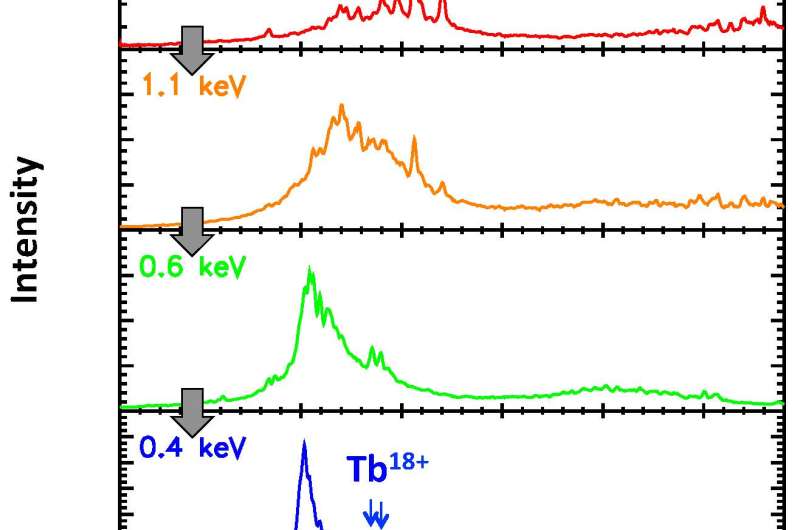The discovery of new emission lines from highly charged heavy ions

By measuring the emission spectrum of the extreme ultraviolet wavelength range, researchers at the National Institute for Fusion Science and Koike of Sophia University have discovered a new spectral line that has not been observed experimentally in the past. This result is not only significant for basic science research, it also is useful fundamental data for plasma application research such as the development of extreme ultraviolet lithography light sources. This research result was presented in an invited talk at the 43rd European Physical Society Conference on Plasma Physics, which was held from July 4, 2016, to July 8, 2016.
Among the elements with a high atomic number from the fifth period and higher in the periodic table (for example, tin, gold, and others), there also are many elements whose full spectrum aspect is unknown in plasma. Because high energy is necessary to generate highly charged ions in which many electrons are stripped, experimental devices that can generate highly charged ions are limited. Further, there are ions whose spectral line wavelengths are predicted by theory, but which have not been verified by experiments. Among these elements, tungsten, tin and lanthanide elements are considered possible candidates for the EUV lithography light sources. Further experimental verification of the theoretical model is required for these highly charged ions.
To achieve fusion energy, research on the confinement of a high-temperature plasma by the magnetic field is being actively conducted around the world. However, impurities that have entered a high-temperature plasma become highly charged ions. In that process, energy gained from the plasma is emitted as light and causes lowering of the temperature. Because the LHD can confine high-temperature plasma in a stable manner for a long period of time and permits a large quantity of impurities, researchers deliberately allow impurities to enter into the plasma. This is beneficial for research on the emission spectrum from highly charged ions.
In the current study, the researchers used the tracer encapsulated solid pellet (TESPEL) developed for investigating the behaviors of impurities in high-temperature plasmas. Tin, gadolinium, tungsten, gold, bismuth, and other elements, which are in the fifth and the sixth periods of the periodic table, were encapsulated in pellets, and injected into an LHD high-temperature plasma. Using the Grazing Incidence Vacuum Ultraviolet Spectrometer, the light emission of the extreme ultraviolet spectrum (wavelength around one to 15 nanometers) was systematically observed. By controlling the heating power after the pellet injection, from the condition of high (>2keV) electron temperature to the hollow condition in which the core temperature becomes zero, we successfully achieved a spectrum in this broad temperature range. The researchers observed dramatic change. And in both the high temperature cases and the low temperature cases, the dominant, highly charged ion spectral lines were observed (Figure 1). Among these, the spectral lines of terbium, holmium, and thulium (atomic numbers 65, 67, and 69) were confirmed experimentally for the first time. There are spectral lines that match theoretically predicted wavelengths and spectrum lines that slip slightly, useful data for the validation of theoretical calculations.
In discovering new spectral lines that had not been experimentally observed until now, these results are significant not only for fundamental research, they also may be important for guiding future applied plasma research. From this research, two-thirds of the elements from atomic number 50 through atomic number 83 have been investigated in the LHD, and a systematic experimental database has been compiled. Among these elements, research is advancing using tin, gadolinium, terbium, and other elements as plasma light sources for use in EUV lithography for next generation conductors. Further, gold and bismuth are candidates for light source materials for high-contrast bio-microscopes that use the so-called water window range. Tungsten, as a wall material for ITER, is required for understanding the light-emission mechanism of ions in a plasma. The experiment database compiled from this research will offer fundamental data helpful for improving the accuracy of simulations.
More information: C Suzuki et al, Temperature dependent EUV spectra of Gd, Tb and Dy ions observed in the Large Helical Device, Journal of Physics B: Atomic, Molecular and Optical Physics (2015). DOI: 10.1088/0953-4075/48/14/144012
Journal information: Journal of Physics B: Atomic, Molecular and Optical Physics
Provided by National Institutes of Natural Sciences




















